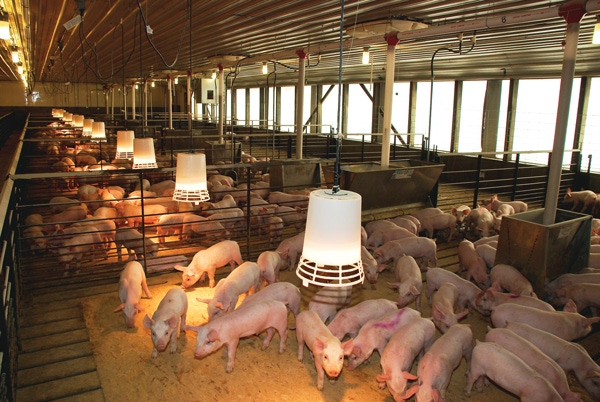No Second Chances
“The typical call I get from a producer is, ‘I can’t get my pigs off to a good start, Doc,’” remarks Minnesota swine veterinarian Tim Loula of the Swine Vet Center (SVC), St. Peter, MN.

“The typical call I get from a producer is, ‘I can’t get my pigs off to a good start, Doc,’” remarks Minnesota swine veterinarian Tim Loula of the Swine Vet Center (SVC), St. Peter, MN.
That comment may be surprising, given all of progressive technologies available today — multi-site production systems, all-in, all-out production flows and wean-to-finish facilities.
But within those technologies there are shortcomings. “We still see too many pigs piling, too many pigs in a pen, not enough light or supplemental heat, and not enough floor mats to keep pigs warm,” Loula laments.
“We are not taking care of weaned pigs as well as we should. When you don’t start them right in the first days, postweaning — chilling them, not feeding them correctly and not being attentive to their needs — you won’t get a second chance. You are going to pay the price for the entire nursery turn.
“Then, when you throw porcine reproductive and respiratory syndrome (PRRS) and/or swine influenza virus (SIV) into the mix, those pigs will not rebound. You will end up with an underperforming batch of pigs,” he says.
Weaned Pig Environment
The fact is, producers had systems that made them better managers back in the early ’90s before wean-to-finish technology and automated feeding systems were developed, Loula observes. Pigs were housed in hot nurseries, that were sometimes equipped with raised decks that kept pigs toasty warm, and they were fed a limited amount of feed several times a day.
“Now we teach workers to pick out the gaunt pigs that in reality haven’t eaten in two days, when we used to identify pigs that hadn’t eaten one meal. When a pig got sick, we identified it right away, and we had a great success rate treating it because he was only starting to get sick rather than two or three days into a disease,” he says.
Small nurseries in the early ’90s had pens that held less than 30 pigs with solid walls and floors, not like today’s wean-to-finish facilities with large pens, open gating and total concrete slats.
“We forget some of that old stuff when we put these weaned pigs down on cold cement, put a heat source over them and wonder why they don’t perform,” Loula reminds.
Flow Preparation
Unlike the traditional farrow-to-finish operation of the past, today’s multi-sourced pigs sometimes travel long distances.
Single-sourcing pigs is still the goal, but that often becomes impractical when filling large barns, says SVC’s Paul Yeske, DVM. He notes that it is more practical to flow pigs through a site all-in, all-out with pigs of similar health status.
“We try to identify the pathogen status of sow farms and match up those pigs to make a flow,” he explains. “It’s more important to match pig sources by health and stability of those animals than to try filling sites more quickly.
“If we’ve got an active-PRRS sow farm, we want to be able to pull that source out of the flow. It works the same way with Mycoplasma pneumonia,” Yeske says.
Ideally, a site would be filled in a day, but it commonly takes seven to 10 days, which can make feed budgeting difficult. The best scenario is to place 21-day-old weaned pigs with no more than a three-day age spread, weighing an average of 15 lb. and from a health-stable sow farm, says Mike Eisenmenger, DVM, at SVC.
Health monitoring on the sow farm and testing sows weekly or monthly are critical to assembling and shipping pig flows (if sources have to be commingled), Yeske continues.
Gilt development and acclimation are other important preparations for healthy pig flows. “For instance, if you have a Mycoplasma-positive sow herd, you want to make sure the gilts that will eventually enter that sow farm turn Mycoplasma-positive prior to their arrival. That will help ensure they aren’t actively shedding virus to their offspring, which would create more disease problems in the grow-finish phase,” Yeske says.
Gilts should be exposed to all of the pathogens that they will encounter at the sow farm, Eisenmenger reinforces.
Weaned pig audits should be conducted monthly, more often if needed. Test 30 pigs for PRRS by polymerase chain reaction (PCR) prior to shipment, Loula suggests.
The big three to test for in sows and pig flows are PRRS, mycoplasma and swine influenza virus. This assumes pig flows are negative for Actinobacillus pleuropneumonia and swine dysentery, he adds.
A prefill plan goes a long way toward helping the people who will be raising those pigs. Arm them with information on pig source, what to be prepared for and the recent history of pig flows, Yeske says. It helps with plans for feed and water medications, how to set the ventilation, number of sick pens needed, etc.
Loading the Barn
Each situation is a little different when filling a wean-to-finish barn, says Brad Leuwerke, DVM, at SVC. Prior to the pigs’ arrival, plan where the small pigs and the health-challenged pigs will go, and where the recovery pens will be located, he says.
“A lot of farms will pick a percentage of small pigs that they want to give extra attention,” Yeske explains. “We often suggest that growers keep a certain percentage of pens open in the barn, which will be automatically filled for special treatment in the first week of arrival,” Leuwerke says.
“Placing them in a new pen allows you to restart them on their feed budget and get them eating so they can catch up with the rest of the pigs,” adds Laura Bruner, DVM, of SVC.
Pen layout decisions should include the best placement for supplemental feeders, mats and heaters (brooders), so they are well-spaced to create designated sleeping, eating and bathroom areas, Leuwerke says.
Use pen cards to tell workers what needs to be done each day, how often it needs to be done, the date pigs entered the pen and the types of pigs in the pen, Eisenmenger suggests.
Gruel, Mat Feeding
In health-challenged pig flows, the entire population may be gruel-fed, says Laura Schulz-Dalquist, DVM, at SVC. In healthier or more stable pig flows, only challenged pigs will be gruel-fed.
Thin gruel should be made from starter feed at a 2:1 ratio of water to feed, Eisenmenger says.
“The point is to always have fresh gruel available, providing just enough so it will be fresh every time you feed it,” Schulz-Dalquist says. Frequent refilling provides the pigs an opportunity to fill up and still leaves a little bit for the small pigs that might otherwise get pushed aside.
Newly weaned pigs are accustomed to a liquid diet. Feeding them a watery gruel the first couple of days helps them transition from semi-liquid feed to the dry feed in the feeder. Up to four gruel feedings a day are recommended, adds Gil Patterson, DVM, at SVC.
Mat feeding also helps pigs transition from eating as a litter. “When they are on the sow, pigs are used to having her call them, grunting when it is time to eat. When they move to the nursery, they have to learn to do that on their own. By mat feeding four times a day or more, you are saying it is time to eat. Mat feeding gives them the ability to eat as a litter again,” Yeske says.
Feed a small amount of feed on the mat at least four times/day for 4-7 days, Eisenmenger says. Place less than ¼ lb./pig/day on the mat. The goal is to teach pigs to eat dry feed, but it is also to find the non-eaters.
Raised Decks
To improve the environment in some wean-to-finish units experiencing small pigs or PRRS-challenged pigs, some SVC producers have added raised decks, Loula says.
“The first decks put in were on a site where the producer had 100 really small pigs out of a group of 3,300 pigs,” he says. Before decks, he tried heat lamps, gruel feeding and alternating antibiotics; two to three weeks after placement, those small pigs often had to be euthanized.
Decks were equipped with heat mats on the floor, three solid sides and nipple waterers set to drip all of the time, and pigs were fed 4-5 times/day. After three days, the producer called to report the pigs were all eating and full-bellied and didn’t require any more treatment, Loula notes.
Vaccination Stress
The timing of vaccinations can add stress to weaning. With PRRS, circovirus, mycoplasma and influenza, more vaccines are administered around weaning than ever before, Leuwerke says.
It’s best to vaccinate a couple of days prior to weaning or wait to vaccinate in the nursery to reduce the overall stress at weaning, he advises.
Health Stability
Overall, the health of the pig flow is determined by the degree of health and quality of management, Eisenmenger points out.
He calculates wean-to-finish (WTF) mortality as follows:
Good health plus good management = 2% WTF mortality;
Good health plus poor management = 5% WTF mortality;
Poor health plus good management = 7% WTF mortality; and
Poor health plus poor management = 10%-plus WTF mortality.
About the Author(s)
You May Also Like





